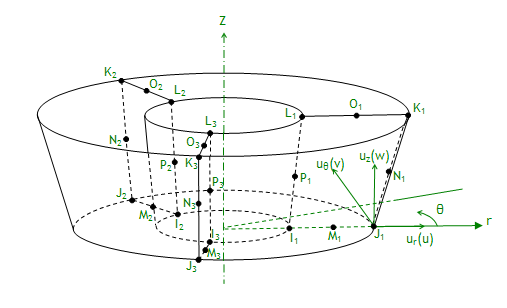
| Matrix or Vector | Geometry | Shape Functions | Integration Points* |
|---|---|---|---|
| Stiffness and Stress Stiffness Matrices; and Thermal Load Vector | Quad | Equation 11–267, Equation 11–268, Equation 11–277, Equation 11–278, and Equation 11–279 | 2 x 2 x Nc |
| Triangle | Equation 11–267, Equation 11–268, Equation 11–280, Equation 11–281, and Equation 11–282 | 3 x Nc | |
| Mass Matrix | Quad | Same as stiffness matrix | 3 x 3 x Nc |
| Triangle | 3 x Nc | ||
| Pressure Load Vector | Same as stiffness matrix, specialized to face | 2 x Nc | |
* Nc = the number of integration points in the circumferential direction. The Nc integration points are circumferentially located at:
the nodal planes, and
midway between the nodal planes (that is, at the integration planes)
so that Nc = (2 * Nnp), where Nnp = number of nodal planes (KEYOPT(2)). Exception: If KEYOPT(2) = 1, then Nc = 1.
| Load Type | Distribution |
|---|---|
| Element Temperature | Biquadratic across element on rz plane and linear between nodal planes in the circumferential direction |
| Nodal Temperature | Same as element temperature distribution |
| Pressure | Linear along each face |
Structures describes the derivation of structural element matrices and load vectors as well as stress evaluations. General Element Formulations gives the general element formulations used by this element.
Although the elements are initially axisymmetric, the loads and deformation can be general in nonaxisymmetric 3D. The displacements are interpolated in elemental coordinate system by interpolation functions, but the user can define the nodal displacements in any direction.


